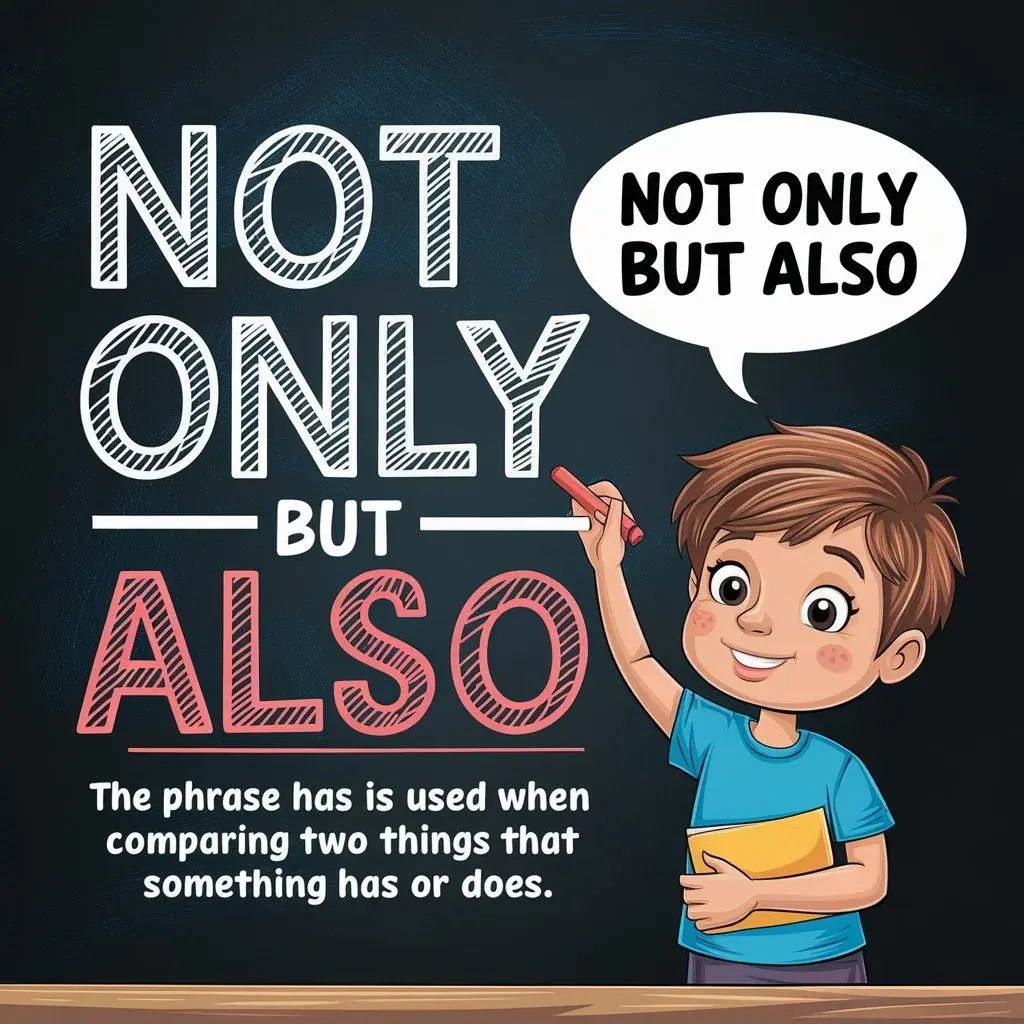The phrase “not only but also” is commonly used when comparing two things that something has or does. Although we frequently use this phrase in conversation, it’s less common in writing. As a result, when we do write it, we don’t always place the comma where it should go. The phrase “not only but also” is an essential tool for emphasizing comparisons in both speech and writing.
Despite being common in conversation, it’s often misused in writing, particularly when it comes to comma placement. Knowing the correct way to structure this phrase allows for more clarity and emphasis in your sentences. Whether you’re comparing actions, objects, or characteristics, “not only but also” can highlight the importance of both elements.
In this guide, we’ll explore the proper usage of the phrase and clarify common mistakes with helpful examples.
Should You Use a Comma?
By default, “not only but also” doesn’t require a comma. However, if you want to add emphasis to your sentence, placing a comma before the “but” can be helpful. So, for emphasis, you would write: “Not only, but also.”
What Does “Not Only But Also” Mean?
Before diving into the rules about this phrase, it’s important to understand its meaning. The phrase “not only but also” is used to emphasize comparison, showing that one thing is paired with another to underscore an important point.
To illustrate, let’s say I want to describe how large my shower is. I might say, “I can fit not only my whole family but also the pets inside too.” Here, the phrase indicates that my family is just one of two things that can fit inside the shower.
If I wanted to emphasize that my pets can also fit in there, I could write, “I can fit not only my whole family, but also the pets inside too.” In this case, the comma adds emphasis to the pets.
Examples of “Not Only But Also”
Let’s look at some examples to better understand the usage of this phrase:
- “He not only killed seven people but also ate a duck for fun. We need to catch this criminal.”
- “He drives not only a Bentley but also a Rolls Royce. It’s clear that this is a man who likes his cars.”
- “I ate not only cheeseburgers but also hot dogs. After I was done, I felt like I had to run 1,000 miles to lose the weight.”
- “I work not only weekends, but also evenings. I just really want to do what’s best for my family.”
- “He went not only to the gym but also the farm shop. He wanted to make changes to become healthier.”
- “My fruit salad had not only apples and pears but also strawberries and blueberries. I knew that this would be a great way to end the meal.”
- “Batman not only stopped the Joker but also the Penguin.”
- “I ran not only to the shop but also back again.”
- “I ate not only pie and mash but also fish and chips.”
- “I am not only human but also part alien.”
- She is not only a talented singer but also an amazing dancer.
- He owns not only a car but also a motorcycle.
- We visited not only Paris but also Rome during our vacation.
- I love not only pizza but also pasta.
- She works not only during the day but also at night.
- He is not only intelligent but also hardworking.
- They play not only football but also basketball.
- The project was not only challenging but also rewarding.
- She speaks not only English but also French.
- He is not only my friend but also my mentor.
- This restaurant serves not only breakfast but also dinner.
- The book was not only well-written but also thought-provoking.
- I have not only a cat but also a dog.
- She traveled not only to Europe but also to Asia last year.
- The movie was not only entertaining but also educational.
- He excels not only in math but also in science.
- The company offers not only competitive salaries but also great benefits.
- I enjoy not only reading but also writing in my free time.
- The event was not only well-organized but also fun.
- She is not only a dedicated employee but also a great leader.
Common Mistakes with “Not Only But Also”
Even though the phrase “not only but also” is relatively simple, it’s easy to make mistakes when using it. Here are some common errors:
- “I read, not only books but also magazines.” In this example, the comma after “read” is unnecessary because “I read” is not an introductory phrase.
- “I read not only books but also, magazines.” Here, placing a comma before “magazines” is incorrect, as the word “magazines” does not need to be separated from the rest of the sentence.
Other Comma Rules to Keep in Mind
The best way to master commas is to familiarize yourself with the main comma rules. Some of these may be new, while others may be a refresher from what you learned in school.
- To separate items in a list:
- Example: “I bought apples, paper, loo roll, milk, and bread.”
- To separate independent clauses:
- Example: “It’s a big plant, but it’s very nice.”
- After introductory words and phrases:
- Example: “Today, I ate three pizzas.”
- To separate multiple adjectives describing the same noun:
- Example: “She is a happy, excitable girl.”
- To separate lists of phrases:
- Example: “I like eating cake, skipping rope, running uphill, and racing.”
- To express contrast:
- Example: “He liked the Beatles, she liked the Stones.”
- To avoid confusion:
- Example: “Jeremy, the boy’s father, came into the room.”
- When separating quotes:
- Example: “I said ‘stop doing that,’ but he kept on doing it.”
- For set expressions that interrupt the flow of the sentence:
- Example: “I watered my plants, a waste of time, and then ate a burger.”
- In dates and addresses:
- Example: “I live in Portsmouth, England.”
- Example: “It’s on the 15th of May, 2021.”
- To separate a statement from a tag question:
- Example: “You went to Brazil last year, didn’t you?”
There are additional rules for commas, but these are the most important ones to keep in mind. Contrary to popular belief, the rule of “inserting a comma when you naturally take a breath” is not an official guideline.
FAQs
When should I use the phrase “not only but also”?
You should use “not only but also” when you want to highlight two related elements or actions to show that both are significant. It’s a great way to add emphasis and make your sentence sound more formal or impactful. For example, “He not only sings beautifully but also plays the piano.” The phrase implies that the person excels in both areas, making both talents stand out. This type of comparison adds depth and makes the message clearer to the reader.
Is a comma always needed in “not only but also” sentences?
A comma is not always required when using “not only but also.” However, if you want to place emphasis on the second element, you can insert a comma before “but also.” For instance, “She excels not only in academics, but also in sports.” The comma here provides a natural pause, allowing the second part of the sentence to stand out more. If there’s no need for emphasis, you can skip the comma entirely, like “She excels not only in academics but also in sports.”
What are common mistakes when using “not only but also”?
One common mistake is using a comma after “not only” or placing a comma before “but also” unnecessarily. Another error is treating “not only but also” as two separate clauses, which breaks the flow. For example, “I read, not only books but also magazines” incorrectly splits the sentence. The correct form is “I read not only books but also magazines.” Additionally, many people forget to parallel the structure of the two compared elements, making the sentence sound awkward.
Can I use “not only but also” in informal writing or speech?
Yes, you can definitely use “not only but also” in both formal and informal contexts. While the phrase adds a level of formality, it is also flexible enough to fit into casual conversations or writing. For instance, in casual speech, you might say, “I not only went to the movies but also had dinner afterward.” Whether you’re writing an academic paper or having a conversation with friends, this phrase is a great tool for emphasizing comparisons in a clear and structured way.
How does the phrase improve my writing?
Using “not only but also” enhances your writing by adding a sophisticated layer of emphasis and structure. It helps you draw attention to two important elements or actions, ensuring that both are equally noticed by the reader. This phrase also improves flow, making your sentence sound more polished and organized. It encourages parallelism, where the sentence’s structure remains balanced. Overall, incorporating this phrase into your writing elevates the clarity and impact of your comparisons.
Can I omit “but also” and still make sense?
While it’s possible to omit “but also” in certain cases, the sentence may lose its full comparative impact. For example, “He not only sings” leaves the reader expecting a second part to complete the comparison. Without “but also,” the sentence feels incomplete and unbalanced. Including both parts of the phrase ensures that your point is made clearly and that the comparison is fully understood. For a complete and well-rounded sentence, always include both “not only” and “but also.”
Conclusion
Mastering the use of “not only but also” can greatly enhance the clarity and emphasis in your writing and speech. By understanding the rules for comma usage and avoiding common mistakes, you can ensure that your sentences are well-structured and impactful. This versatile phrase is suitable for a variety of contexts, whether formal or informal, allowing you to communicate comparisons effectively. Remember, adding emphasis through “not only but also” helps your reader or listener pay attention to both key points in your message. As the writer William Zinsser once said, “Clutter is the disease of American writing.” Using phrases like “not only but also” correctly helps eliminate clutter and keeps your writing clear and concise.

I’m Mira Sinclair, the expert helping you navigate grammar sections at “Grammer Grove.” Playing with words and expressions is my thing. At Grammer Grove, we’re here to make yourwriting stand out and shine. Let’s make your appreciation heartfelt and memorable—come and join the fun at Grammer Grove!












